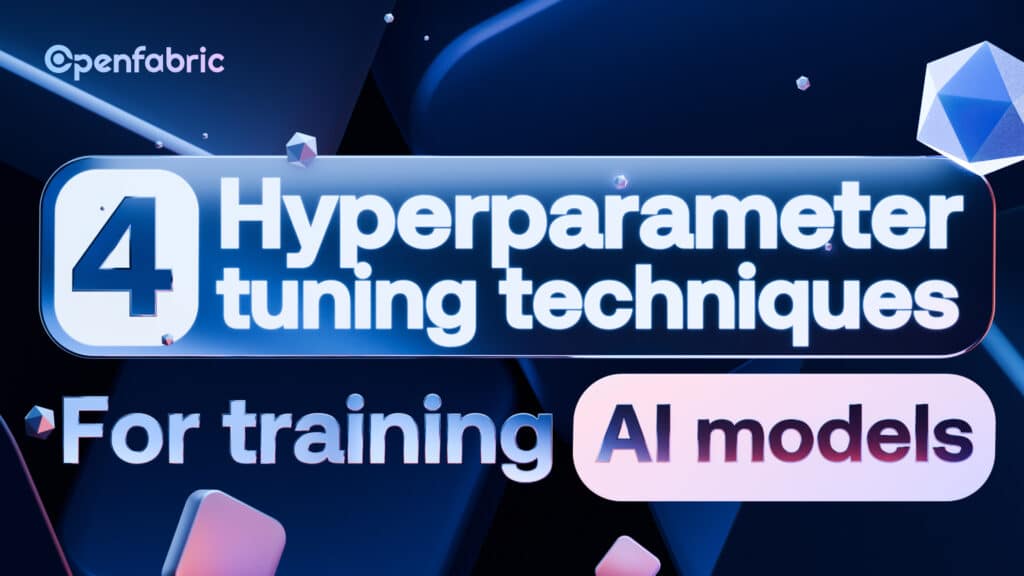
February 21, 2025 7 minutes read
4 Hyperparameter tuning techniques for training AI models

Training AI models is a technical process. Developers make calculations and decisions that would ultimately affect the outcome of the outcome. Essentially, the AI models we see and use today have a lot of behind-the-scenes before the final product is released for use. One of these processes is known as hyperparameter tuning and the techniques AI developers use to achieve fine-tuning are called hyperparameter tuning techniques.
Okay, let us go back a little bit.
In our previous blog, we looked into hyperparameters in detail. In particular, we talked about the various categories of hyperparameters and the role each of them plays in training AI models. However, for this topic, we will remind ourselves of some of these concepts.
Hyperparameters are external configuration variables that govern the training process of a machine learning model. Essentially, they are a set of rules that the model follows during its training. Although hyperparameters and parameters are two independent concepts, they may be interchanged for one another. Simply put, hyperparameters are external variables learned by the AI model, while parameters are the internal variables that the AI model learns from the given data set.
Although we cannot talk about the basics of hyperparameters right now, you can read more about it in the previous blog post.
While hyperparameters help in the development of AI models, a combination of the wrong hyperparameters will cause the AI model to malfunction. This is where hyperparameter tuning techniques come in. There are several hyperparameter tuning techniques developers use for optimization. We will discuss these techniques in this article alongside their respective pros and cons.
Let’s dive in!
What is hyperparameter tuning?
Hyperparameter tuning is the process of selecting the optimal set of hyperparameters for a machine-learning model. This step is important in the development of AI models as it directly affects the performance of the AI model.
Essentially, a fine-tuned set of hyperparameters ensures that an AI model turns out well. It also improves the performance of an existing AI model by optimizing the training process. On the other hand, poorly tuned hyperparameters will result in AI models that either underfit or overfit the data.
In addition, hyperparameter tuning enables AI models to generalize well, ensuring that it can better adjust to unpredictable conditions. Furthermore, it helps developers save cost and computational time in the creation of AI models.
We could go on and on about the benefits of hyperparameters. Ultimately, the main thing to take away is that AI models can only operate well because of the hyperparameters we use.
Hyperparameter tuning techniques for training AI models
There are many hyperparameters in the hyperparameter space. It’s like a whole world of hyperparameters and each part of this world represents an individual hyperparameter. Therefore, we can see how choosing the right one, for an AI model, without any guide or framework could be a huge problem. However, we have these hyperparameters tuning techniques which make the process so much easier. Let us see these various hyperparameter tuning techniques used in the training of AI models, as well as their pros and cons:
Grid search
Grid search is a hyperparameter tuning technique that trains a model exhaustively for possible combinations of hyperparameters in a specified subset in the hyperparameter space. In a grid search, the developers typically run experiments or processes on several defined conditions, i.e. hyperparameters. Furthermore, grid search is more practical when:
- The total number of parameters in the model is small.
- The solution is within a specific range of values. Therefore, this range can be used to define the limits of the grid.
When the conditions are ideal, the combination of hyperparameters is used to train the model and evaluated against the specific range of values. Finally, the combination of hyperparameters that give the best model performance is chosen as the optimal set.
What are the pros and cons of this technique?
Pros
The grid search method is simple and effective, especially for smaller and simple AI models.
Cons
There are many problems with the grid search method. Firstly, the number of parameters to use is small, which limits the model. Also, the predefined range of values may not include the optimal value for the hyperparameter. Lastly, this method requires a lot of computation because it involves training individual models for a set of hyperparameter combinations.
Random Search
Random search is a step up from the grid search hyperparameter tuning technique in terms of improvements. It involves a randomized search of a combination of hyperparameters from certain distributions and training a model using those sets of hyperparameters.
Basically, a predefined set of hyperparameters is chosen, and then the algorithm selects a random combination of these variables. This is what the model is trained on and evaluated using a metric such as the accuracy of the model. The training is repeated several times, or at least until a desired set of accuracy is achieved.
Let us see the pros and cons of this technique.
Pros
Although random search is a simple hyperparameter tuning technique, it is more effective than grid search in that:
- The random search technique can work better especially if the multiple hyperparameters are not uniformly distributed. This is because it explores a wider range of combinations by randomly sampling values.
- It is highly unlikely to use suboptimal areas of the hyperparameter space.
- Also, random search uses a few combinations of hyperparameters from a defined distribution and not every possible combination. This helps to maximize the system’s efficiency by reducing computational cost and time.
Cons
It does not guarantee the best possible combination, unlike grid search.
Bayesian search
Bayesian search is a common hyperparameter tuning technique that uses Bayesian optimization (BO) to find the best hyperparameter combination for an AI model.
BO uses the previous set of hyperparameters to determine the probable future set of hyperparameters to use. Then, it uses this new set of hyperparameters to predict the next set of hyperparameters to use to achieve the improvement in the performance of the AI model. This process goes on and on until the optimal set of hyperparameters is found.
Essentially, we can simplify the working process of BO in five steps::
- Building a probabilistic model of the objective function.
- Finding the best hyperparameter values in the model.
- Applying those optimal values to the objective function.
- Updating the model with the new set of results.
- Repeating the above steps until achieving optimal hyperparameters.
It also has pros that we must consider before using. Let’s look at some of them.
Pros
- It can leverage any information about the objective function of the AI model to find the optimal hyperparameters.
- It can detect optimal combinations of hyperparameters by analyzing previously tested values.
- It is ideal for large and complex models.
Cons
- It is more complex
- It requires more computational resources
Hyperband
This hyperparameter tuning technique uses a bandit-based approach, which is faster than other traditional optimization methods, to efficiently search the hyperparameter space.
This technique works by running a series of “bracketed” trials. In these trials, the model is trained using a range of different hyperparameter configurations at each cycle. The evaluation of the model’s performance is done using a specified metric, such as accuracy or F1 score. Eventually, the model with the best performance is selected, and the hyperparameter space is narrowed to focus on the most promising configurations. This process is repeated until the optimal set of hyperparameters is found.
Pros
- It works faster by eliminating configurations that are not ideal
- It is ideal for situations where the objective function is scattered and expensive to evaluate
What hyperparameter tuning technique is ideal?
Hyperparameter tuning techniques depend entirely on the model to be trained. As such, it might not be easy to accurately pick an ideal hyperparameter tuning technique. However, you might want to consider these factors before choosing a technique for training your AI model. These factors include:
- The objective function of the model
- Cost and budget for building the model.
- The level of complexity of the model
- The time available for building the AI model
- The technical knowledge available for the development of the model
Having all of these factors aligned and sorted is the first step to building an AI model that works well.
Conclusion
Hyperparameter tuning techniques are the configurations we use to train our AI models to function the way we want them to function. The different hyperparameters allow us to tailor our AI development in terms of complexity and the budget for the development. Without hyperparameters tuning techniques, AI models would take years to develop and we would not be where we are today regarding AI advancement.
For more information and updates, visit our WEBSITE today!

